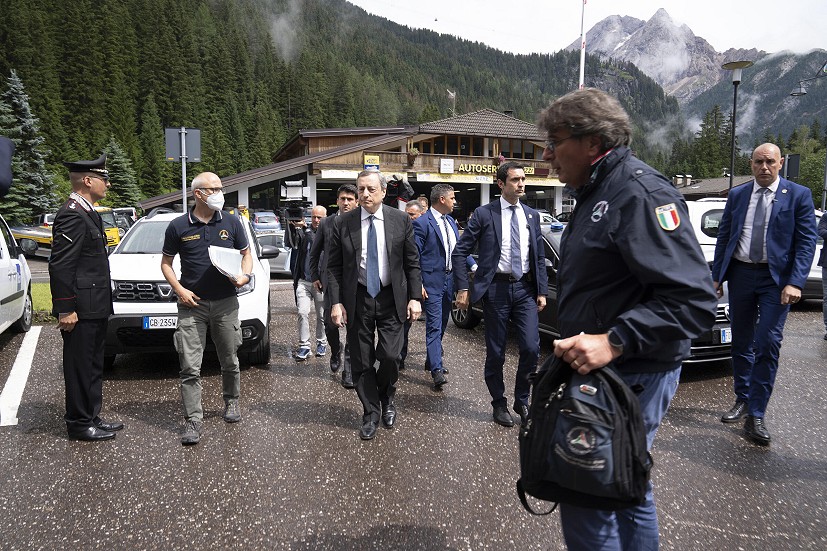
As widely reported in mainstream media, at least ten people have died and a further two are reported missing and feared dead following a major serac collapse from the top of the Marmolada glacier in the Italian Dolomites last Sunday 3 July. Temperatures near the summit had reached a record 10°C in the afternoon of the collapse.

The section of ice and debris that fell is estimated to have been around 200 metres long, 60 metres wide and 30 metres thick. "Two football fields, 30 metres thick," the governor of Veneto, Luca Zaia, told Italian press.
Among those confirmed dead are two Italian mountain guides. "This accident is a tragedy for the whole valley and the whole alpine community," Stefan Stuflesser, a mountain guide and ski instructor based in the Dolomites, told UKC. "Since the first ascent of the Marmolada almost 140 years ago, there has never been such a great tragedy on this mountain."
Antoni Montani, General President of the Italian Alpine Club, expressed his sympathy for the families of the victims. "I join in the deep sorrow that has struck the families of the victims of the tragedy, and I express to them and to the injured involved in the collapse my closeness and that of the Italian Alpine Club," he said. "I thank the Mountain Rescue Service and all the Civil Defence volunteers for their tireless work."
Italian Prime Minister Mario Draghi visited the site of the accident in the town of Canazei. "This is a tragedy that certainly had an element of the unpredictable but is also without doubt linked to the deterioration of the environment and the climate situation," he said in a press statement.
***
Already it's clear that it's a terrible year for glaciers. - Matthias Huss, glaciologist
Over the course of the last century, temperatures in the European Alps have increased by around 2°C — twice the global average. This summer, heatwaves have caused record-breaking June temperatures across the continent, with central and southern areas of Italy hitting up to 40 degrees Celsius.
The glacier on the Marmolada (3,343m) - the highest mountain in the Dolomites, known as the 'Queen of the Dolomites' - has lost more than 80% of its volume in over the last 72 years and scientists predicted in 2020 that its glacier could vanish within 15 years. The rate of retreat is increasing: one study in 2019 analysed a ten-year (2004-2014) evolution of the glacier's ice thickness and volume and recorded a loss of about 30% in ice volume and about 22% in ice coverage.
Prior to the accident, the weather station at Punta Rocca della Marmolada (3,250m, situated just above the calving site) had measured above 0°C for 23 days running, with just one exceptional day of frost, the non-profit Italian meteorological society NIMBUS reported.
Matthias Huss, glaciologist and head of the Swiss Glacier Monitoring Network Switzerland (GLAMOS), explained the importance of acknowledging the long-term impact of rising temperatures when considering the cause of the collapse.
"In my opinion, people are quick to make the heatwave - collapse connection," he told UKC. "Of course, the particular weather conditions played a certain role, but it was the retreat of the glacier over the last decades and years - driven by climate change - that brought it into that instable situation. The hot weather was just the final trigger."
The specific process which led to the serac collapse is still unclear and is under investigation as officials secure the area for continued search and recovery operations using drones and search teams.
"It is obvious, however, that the collapse was not due to the quite common process of ice break-off from hanging glaciers seen everywhere in the high Alps," Huss said. "The site was not known to be dangerous before. Therefore, it was almost impossible to recognise the danger, both for alpinists and officials."
Compared to other Alpine ranges at higher elevations, the Dolomites has few glaciers and the Marmolada is the largest in the range by a significant margin. Unlike some Alpine glaciers - notably the Planpincieux Glacier on the Grandes Jorasses, which hangs precariously above the eponymous hamlet and prompted an evacuation in 2020 - the Marmolada's topography and small scale had not previously caused alarm to scientists or residents.
"In general, ice break-off events can be predicted, but only if there is a known danger beforehand and extensive monitoring is installed, such as measuring the displacement over time," Huss explained. "Neither were present in the case of the Marmolada, which ultimately led to the disaster."
"However, bad luck was also involved: it could have happened in the middle of the night, instead of a busy Sunday morning," he added.

Mountain guide Stuflesser has worked as a guide for 40 years and typically climbs on the Marmolada a few times a year, both in summer and in winter. He has witnessed the glacier retreat "unbelievably" in this short period of time. "As a rough visual estimate, it's probably by around 500 metres," he said. "But what has changed a lot in the last few years is the amount of snow. Early in my career, I remember climbing on snow in August. Nowadays there is almost no snow in July - even worse this year, due to minimal winter snowfall - almost only ice." This lack of snow cover on the ice accelerates its rate of warming.
Some online commenters criticised the deceased mountain guides who took clients on the mountain on the day of the accident, sharing a video of running subglacial water taken and posted online by a local hut guardian the day before the collapse.
"Unfortunately a lot of negative things have been written and especially by a lot of incompetent people," Stuflesser said. "I firmly believe that the accident that happened on Sunday could not have been foreseen by anyone. The whole tragedy can perhaps be compared to an earthquake, to make a banal comparison. I can perhaps agree that due to the warming and excessively high temperatures at this time of year, the conditions for a climb were not optimal. Nevertheless, the ascent of the Marmolada, even with these conditions, would normally be no problem at all for a skilled and experienced alpinist."
As mountains continue to present increased objective dangers through climate change - such as serac collapse, avalanches, rockfalls and flooding - guides are being forced to choose their objectives carefully.
"Mountain professionals have had to adapt strongly to changing landscapes and conditions and are always learning," Stuflesser said. "For almost 30 years now, numerous ice routes have only been relatively safe to climb in winter or spring. But there will never be 100% safety from seracs and ice avalanches."
President of the Italian guiding school, Martino Peterlongo, told Italian newspaper La Repubblica that avalanche bulletins have their limitations and that mountain closures are "only a last resort". "In the Alps, weather changes have become sudden, it is up to us to understand better and sooner how to orient ourselves in the event of unpredictable events such as the collapse of Punta Rocca," he said.
Following the collapse, two suspended seracs have been left exposed, which are now under continuous monitoring. Over the past week, local authorities in Canazei have closed a section of road and multiple paths leading high up on the Marmolada and one house was evacuated as a precaution. The potential for further collapses and the impact of safety restrictions on local tourism and livelihoods during the peak summer season are growing concerns for those living and working on the mountain and in neighbouring villages.
In terms of further glacial retreat, the Marmolada's elevation at 3,343m places it in a high-risk zone, as a team of researchers have predicted that most if not all glaciers below 3,500m in the European Alps will have disappeared by 2050. The scientists named this threshold the 'Environmental Equilibrium Line Altitude'; the altitude at which glacial accumulation and ablation are equal and considered balanced. According to one study, if present climatic conditions are maintained, the more widely- known Argentière Glacier and the Mer de Glace in the Mont Blanc Massif could also disappear by the end of this century.
It remains to be seen, Huss said, whether temperatures over the next two months will exceed the record high Alpine temperatures of the 2003 heatwave, which led to increased glacier-melt and rock and ice falls. "At the moment the glaciers in the Alps are in very bad shape," Huss explained. "Never since observations started have they been on track towards so much ice loss at this time of the year."
"Already it's clear that it's a terrible year for glaciers," he added. "The situation really is alarming. We've seen many bad years, but this one is different for three reasons: extremely little snow in winter, early and intense heat, and Saharan dust on the snow in March — accelerating melting by absorbing more radiation. It's a toxic combination."
***
Scientists estimate that climate change is affecting major mountain ranges two to three times faster than the rest of the world. One-third of Himalayan glaciers — at the very least — are predicted to disappear by 2100, as temperatures rise at a rate estimated to be up to three times the global average.
As governments aim to meet the long-term Paris Agreement temperature goal to limit global warming to below 2°C and towards 1.5°C, mountains face elevation-dependent warming, shrinking glaciers, reduced snow cover and changing precipitation patterns, causing knock-on effects for water supply, energy production, ecosystem integrity, agricultural and forestry production and disaster preparedness.
In August 2021, ahead of COP26, the IPCC released a special report on the impact of climate change in the mountains for the first time in the panel's history. Building on this, notably the 'High Mountain Areas' chapter, the latest paper from February 2022 assessed new evidence on observed and projected climate change impacts in mountain regions, their associated risks and adaptation measures.
Read the Mountains chapter in full (and the full IPCC report) here.
Read our UKC/UKH articles on issues relating to climate change and the environment:
- ARTICLE: International Mountain Day 2023 - Mountains & Climate Science at COP28 11 Dec, 2023
- ARTICLE: Dàna - Scotland's Wild Places: Scottish Climbing on the BBC 10 Nov, 2023
- INTERVIEW: BMC CEO Paul Davies on GB Climbing 24 Aug, 2023
- ARTICLE: Spectacular Sights at Great Height - Visual Phenomena in the Mountains 27 Mar, 2023
- ARTICLE: Using OpenAI to Create Climbing Content and Images 27 Dec, 2022
- ARTICLE: COP27 and the Cryosphere - No Mountaintop Miracles 11 Dec, 2022
- ARTICLE: Coronation Coincidence: Everest 1953 and Queen Elizabeth II 13 Oct, 2022
- ARTICLE: Meet Ralph, the First Canine Compleatist of the Grahams 4 Aug, 2022
- ARTICLE: Climbers and Guides Adapt to Changing Climate and Landscape in the Alps 28 Jul, 2022
- ARTICLE: Earth Day 2022: Climate Change and Mountains - The Latest Science 22 Apr, 2022
















Comments
I reviewed my pictures of the Marmolada from 2008 to 2015. From a good covering of snow, to mostly ice but harmless, to the crevasses opening up. I looked at that FB video linked in your article and was shocked at how much it’s changed / lost volume even since 2015, the last time I descended from summit via the glacier. Even then it was much warmer than previous years and the glacier snow soft when descending.
I also found that you can clearly see the bit that collapsed on some of photos I took in 2008 and 2011. Even then it seems the ice that broke away had a distinct boundary with the surrounding glacier. But there was much more ice and snow surrounding it.
Are you able to share your pics with us?
Also - ~360,000 tonnes of Serac fell if the measurements quoted are correct :-O
July
I climbed Via dei Finanzieri in 2002. Its upper section finishes up the piece of glacier that collapsed (not my photos): http://www.alpinistidellambrusco.org/2009/07/marmolada-via-dei-finanzieri.html these guys did it in 2009. The article is dated July. Their first photo shows the line of the route. Shocking the difference then and now.
Shocking also to think that I, like these guys, climbed it because it was known to be a great training route - a good, safe line for learning the rudiments of ascending glacier ice...
"Since the first ascent of the Marmolada almost 140 years ago, there has never been such a great tragedy on this mountain." Can you maybe edit this line - it's rather insensitive in its wording maybe it was taken out of context here. But given that thousands of troops were stationed here during the war and fought and died in pitched battles inside the glacier, not to mention those who perished due to environmental conditions etc, or the thousands who died in an avalanche in a camp in Malga Ciapela beneath the mountain. I am 100% sure that Mr Stufflesser was no thinking about it in this context, but even so, a huge number have died on that mountain during the last 150 years...